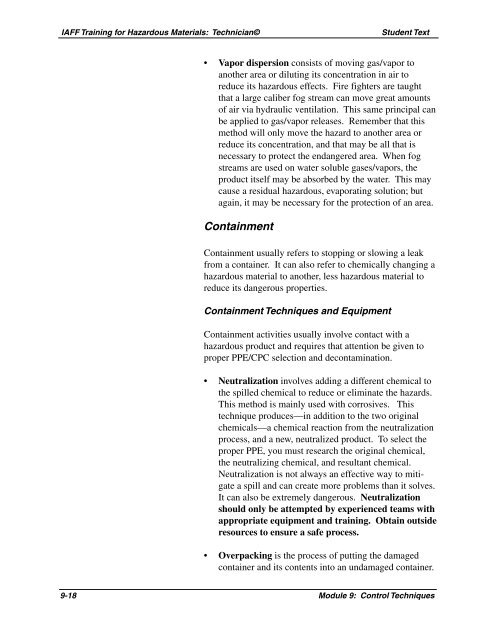Module 9: Control Techniques - International Association of Fire ...
Module 9: Control Techniques - International Association of Fire ...
Module 9: Control Techniques - International Association of Fire ...
Create successful ePaper yourself
Turn your PDF publications into a flip-book with our unique Google optimized e-Paper software.
IAFF Training for Hazardous Materials: Technician©<br />
Student Text<br />
• Vapor dispersion consists <strong>of</strong> moving gas/vapor to<br />
another area or diluting its concentration in air to<br />
reduce its hazardous effects. <strong>Fire</strong> fighters are taught<br />
that a large caliber fog stream can move great amounts<br />
<strong>of</strong> air via hydraulic ventilation. This same principal can<br />
be applied to gas/vapor releases. Remember that this<br />
method will only move the hazard to another area or<br />
reduce its concentration, and that may be all that is<br />
necessary to protect the endangered area. When fog<br />
streams are used on water soluble gases/vapors, the<br />
product itself may be absorbed by the water. This may<br />
cause a residual hazardous, evaporating solution; but<br />
again, it may be necessary for the protection <strong>of</strong> an area.<br />
Containment<br />
Containment usually refers to stopping or slowing a leak<br />
from a container. It can also refer to chemically changing a<br />
hazardous material to another, less hazardous material to<br />
reduce its dangerous properties.<br />
Containment <strong>Techniques</strong> and Equipment<br />
Containment activities usually involve contact with a<br />
hazardous product and requires that attention be given to<br />
proper PPE/CPC selection and decontamination.<br />
• Neutralization involves adding a different chemical to<br />
the spilled chemical to reduce or eliminate the hazards.<br />
This method is mainly used with corrosives. This<br />
technique produces—in addition to the two original<br />
chemicals—a chemical reaction from the neutralization<br />
process, and a new, neutralized product. To select the<br />
proper PPE, you must research the original chemical,<br />
the neutralizing chemical, and resultant chemical.<br />
Neutralization is not always an effective way to mitigate<br />
a spill and can create more problems than it solves.<br />
It can also be extremely dangerous. Neutralization<br />
should only be attempted by experienced teams with<br />
appropriate equipment and training. Obtain outside<br />
resources to ensure a safe process.<br />
• Overpacking is the process <strong>of</strong> putting the damaged<br />
container and its contents into an undamaged container.<br />
9-18 <strong>Module</strong> 9: <strong>Control</strong> <strong>Techniques</strong>
















